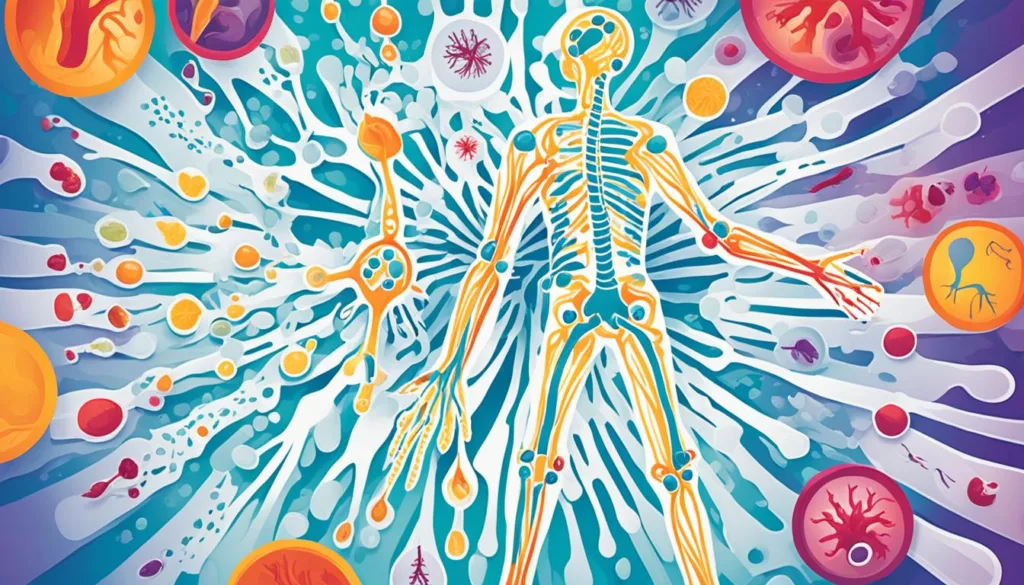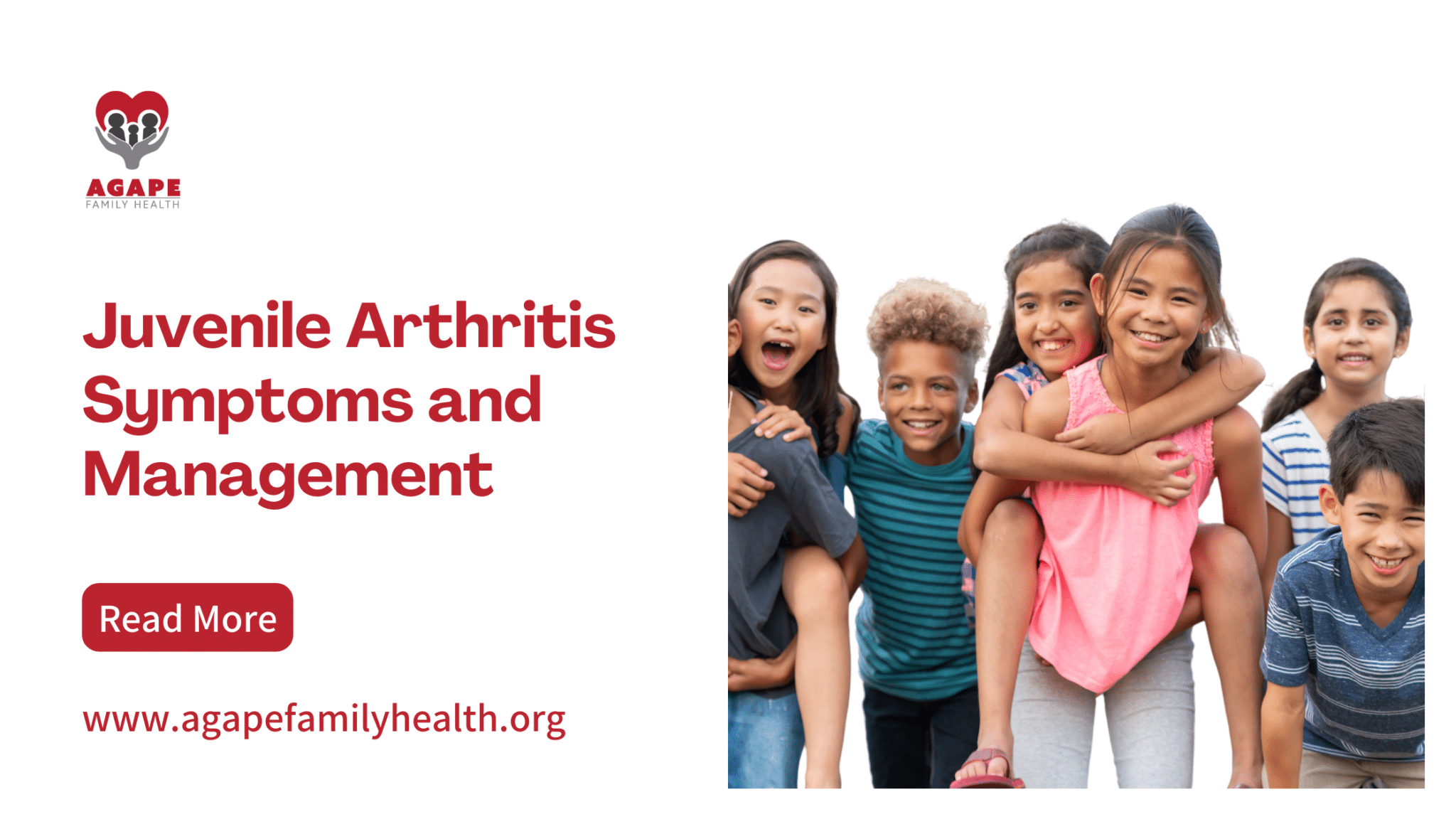In the United States, hundreds of thousands of kids and teens deal with juvenile arthritis . This is a group of diseases that cause inflammation and affect people under 16. The most common type, called juvenile idiopathic arthritis (JIA), causes ongoing pain, swelling, and stiffness in the joints. This can really affect a child’s life. Some types of JIA can also lead to serious issues like problems with growth, damage to the joints, and eye inflammation if not treated. In this article, we’ll help you understand juvenile arthritis symptoms and management strategies.
Key Takeaways
- Juvenile idiopathic arthritis is the most common type of arthritis in children under 16 years old.
- JIA can cause persistent joint pain, swelling, and stiffness, with symptoms ranging from a few months to many years.
- Untreated JIA can lead to serious complications like growth problems, joint damage, and eye inflammation.
- JIA occurs when the body’s immune system attacks its own cells and tissues.
- Regular medical care and treatment is crucial for managing JIA and preventing long-term complications.
Understanding Juvenile Idiopathic Arthritis
What is Juvenile Idiopathic Arthritis?
Juvenile idiopathic arthritis is a type of arthritis that affects kids 16 and younger. It’s not the same as adult rheumatoid arthritis, as kids often outgrow it. But, it can still affect bone growth during these critical years.
The cause of juvenile idiopathic arthritis is still a mystery, but it’s thought to be an autoimmune disorder. This means the body attacks its own healthy cells and tissues. Genetic and environmental factors might also play a part. The CDC informs about one in 1,000 U.S. kids have JIA, with around 9 new cases per 100,000 people each year.
JIA usually starts before a child turns 16, sometimes even as early as 6 months. How severe it is can affect long-term health. Some kids might still have arthritis as adults, while others may have periods without symptoms.
- Systemic-onset JIA is rare but can be severe, similar to Adult Onset Still’s Disease.
- Polyarthritis affects many joints and can turn into rheumatoid arthritis, impacting the legs, arms, jaw, and neck.
- Oligoarthritis is a persistent form that affects 1 to 4 joints, often the wrists or knees, and can also affect the eyes.
- Enthesitis-related arthritis is similar to spondyloarthritis in adults and may involve the sacroiliac joint.
- Psoriatic arthritis in children with JIA is when arthritis comes with psoriasis or nail disease.
Symptoms of JIA include swollen, red, or warm joints; rash; stiffness; low back pain; and bodywide symptoms like pale skin and swollen lymph nodes. Treatment options include NSAIDs, corticosteroids, and DMARDs.
Early diagnosis and treatment help control inflammation, ease pain, prevent joint damage, and keep the child functional. Without strong treatment, most kids with juvenile arthritis will still have active arthritis 10 years later.
Juvenile Arthritis Symptoms
Juvenile idiopathic arthritis is the most common arthritis in kids and teens in the U.S. Its symptoms vary by type and severity. Parents and caregivers should know the common signs.
JIA often causes joint pain, swelling, and stiffness, especially in the morning. Children may also have trouble moving, fever, swollen lymph nodes, rashes, fatigue, and less appetite or slow growth. The symptoms depend on the Juvenile idiopathic arthritis type and affected joints.
- Joint pain, swelling, and stiffness, especially in the morning or after rest
- Limited mobility and range of motion in affected joints
- Fever, especially in cases of systemic Juvenile idiopathic arthritis
- Swollen lymph nodes
- Skin rashes
- Fatigue and decreased energy levels
- Slow growth or poor appetite
Some kids with Juvenile idiopathic arthritis have symptoms for just a few months, while others have ongoing issues. The symptoms and their severity differ from child to child. Working closely with a healthcare provider is key to managing the condition well.
| Symptom | Description |
| Joint Pain, Swelling, and Stiffness | The most common symptoms of JIA, often worse in the morning or after rest |
| Limited Mobility | Affected joints may have reduced range of motion and flexibility |
| Fever | Especially common in cases of systemic JIA, with fluctuating fever patterns |
| Rashes | Skin rashes may accompany joint inflammation, particularly in systemic JIA |
| Fatigue and Poor Appetite | General symptoms that can impact a child’s overall health and well-being |
Knowing the signs of juvenile arthritis is crucial for early detection and proper care. Early action can greatly improve a child’s life and reduce long-term risks. If you think your child might have JIA, see a healthcare provider for a diagnosis and treatment plan.
Types of Juvenile Idiopathic Arthritis
Juvenile idiopathic arthritis is the most common type of arthritis in children, affecting about 1 in 1,000 kids in the U.S. It comes in several subtypes, each with its own set of symptoms and treatment plans.
Different Forms of Juvenile Idiopathic Arthritis
The main types of juvenile idiopathic arthritis include:
- Oligoarticular Juvenile Arthritis: This is the most common form, affecting about 50% of kids with juvenile arthritis. It usually involves four or fewer joints and is more common in girls.
- Polyarticular Juvenile Arthritis: This type affects around 30% of kids with juvenile arthritis. It involves five or more joints and is more common in girls.
- Systemic Juvenile Arthritis: About 20% of kids with juvenile arthritis have this type. It is marked by fever, rash, and inflammation in multiple organs.
- Enthesitis-Related Arthritis: This form is more common in boys over 6. It involves inflammation at the sites where tendons and ligaments attach to bones.
- Psoriatic Juvenile Arthritis: Kids with this type may have arthritis and a skin disease (psoriasis) or a family history of psoriasis.
According to the Centers for Disease Control and Prevention (CDC), JIA is the most common type of arthritis in kids. It affects nearly 300,000 kids under 18 in the U.S. The CDC says about nine new JIA cases happen per 100,000 people each year.
| Type of JIA | Prevalence | Characteristics |
| Oligoarticular | 50% | Affects 4 or fewer joints, more common in girls |
| Polyarticular | 30% | Affects 5 or more joints, more common in girls |
| Systemic | 20% | Characterized by fever, rash, and inflammation of multiple organs |
| Enthesitis-Related | – | More common in boys over 6, involves inflammation at tendon/ligament attachment sites |
| Psoriatic | – | Associated with psoriasis or family history of psoriasis |
According to National Institutes of Health (NIH), about half of JIA patients will still have active disease after 10 years. 30-50% of kids with JIA may still have arthritis as adults. Early and aggressive treatment is key to managing JIA and improving long-term outcomes for kids.

Diagnosis and Treatment
Diagnosing juvenile idiopathic arthritis is complex because there’s no single test. Doctors take a detailed history, perform a physical check-up, and run blood tests. These tests look for inflammation and autoimmune signs.
Blood tests like the erythrocyte sedimentation rate (ESR) and C-reactive protein (CRP) show how much inflammation there is. They check for antinuclear antibodies (ANA) and rheumatoid factor too. These autoantibodies suggest certain autoimmune conditions.
Tests such as X-rays, CT scans, and MRIs help see joint damage and track the disease’s progress. They show the changes happening in the joints.
After diagnosing JIA, treatment combines medicines, physical and occupational therapy, and lifestyle changes. Nonsteroidal anti-inflammatory drugs (NSAIDs), disease-modifying antirheumatic drugs (DMARDs), corticosteroids, and biologic therapies are common treatments.
Physical and occupational therapy ease pain, improve joint movement, and strengthen muscles. Staying healthy, exercising regularly, and using heat or cold can also help manage JIA.
Keeping a close eye on treatment, adjusting medications, and getting care from a team of doctors, therapists, and mental health experts is key. This approach helps manage JIA and improves outcomes for kids with this condition.
Managing JIA in Children
Managing juvenile idiopathic arthritis means looking after both the body and mind of the child. It’s not just about medicine. Important lifestyle changes and support can make a big difference in a child’s life.
Lifestyle Changes for Juvenile Arthritis
Living a healthy life is key to handling juvenile idiopathic arthritis symptoms and keeping joints safe. Here are some lifestyle tips for kids with juvenile idiopathic arthritis:
- Regular exercise helps with joint movement, muscle strength, and fitness. Activities like swimming, cycling, and stretching are good choices.
- Eating a balanced diet full of fruits, veggies, whole grains, and lean meats can lessen inflammation and boost health.
- Stress-reducing activities like yoga, meditation, or deep breathing can help with pain and feelings.
- Getting enough sleep lets the body heal and fight inflammation.
- Steer clear of activities that make joint pain worse, like too much weight-bearing or contact sports.
Support for Children with Juvenile Arthritis
Children with JIA also need a strong support network. Here are some key sources of help:
- Healthcare teams with doctors, therapists, and mental health experts offer full care.
- Learning about JIA and how to manage it helps patients and families.
- Support groups and networks connect kids and families, offering emotional support and advice.
- Changes at school, like easier PE classes or special devices, help kids with JIA join in.
- Groups and organizations work to spread awareness and get more resources for kids with JIA.
Combining medical care, lifestyle changes, and support helps kids with juvenile idiopathic arthritis manage their condition. This way, they can stay well and live a full life.
Conclusion
Managing juvenile idiopathic arthritis can be tough for kids and their families. But, the good news is that many young patients have a bright future ahead. Thanks to new medical advances and ongoing research, the future looks brighter for kids with juvenile arthritis. By spreading the word and pushing for early diagnosis and treatment, doctors can help every child with juvenile idiopathic arthritis in the U.S. live a happy and active life.



